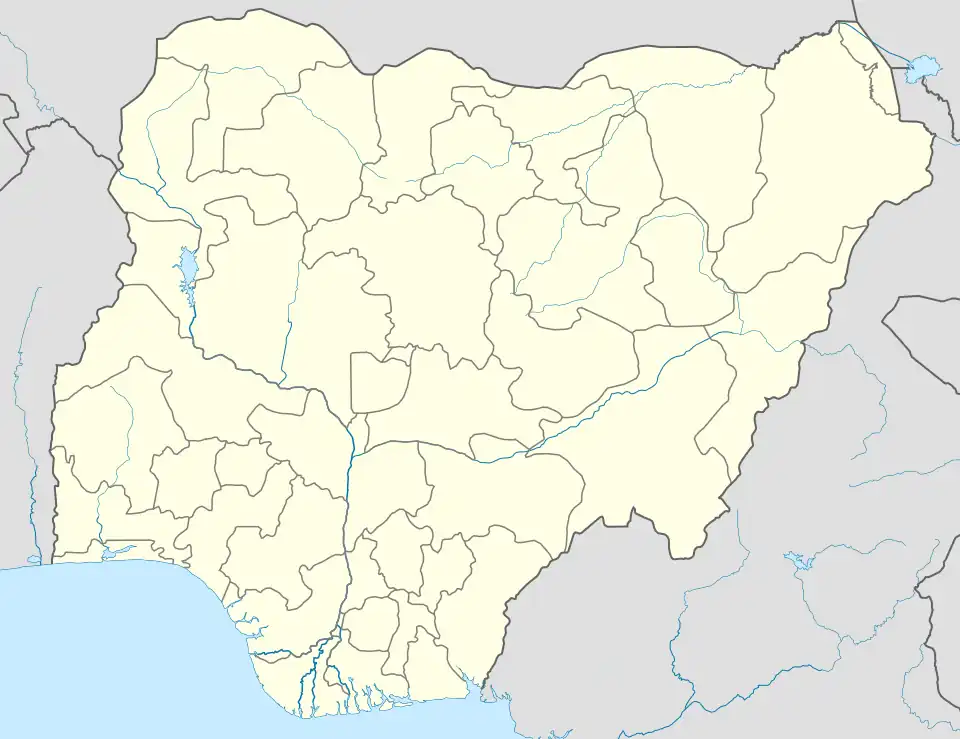Omo Forest Reserve
Omo Forest Reserve is a preserved area of tropical rainforest in Ogun state, in the south-western part of Nigeria. It is located about 135 km (84 mi) northeast of Lagos and 80 km (50 mi) east of Ijebu Ode. This nature reserve covers an area of 130,500 hectares (322,000 acres). The average rainfall is around 2,000 mm (80 in). The terrain is largely flat and well-drained, with some low rolling hills, and forms part of the Omo River watershed.[1]
| Omo Forest Reserve | |
|---|---|
 Omo Forest Reserve shown within Nigeria | |
| Location | Ogun, Nigeria |
| Nearest city | Ijebu Ode |
| Coordinates | 06°51′00″N 04°22′48″E |
| Area | 130,500 hectares (322,000 acres) |
Description
This forest reserve consists of a large area of tropical rainforest covering 130,500 hectares (322,000 acres). In the northern part of the reserve, the vegetation consists of a dry evergreen mixed deciduous forest, while in the south, it consists of a moist, mixed, semi-deciduous forest. Parts of the reserve consist of primary forest with mature trees, especially near the watercourses. However, large portions have been disturbed, with the felling of the original trees and the establishment of plantations. At the centre of the reserve, a plot of 640 hectares (1,600 acres) has been designated a strict nature reserve, and this portion is now a UNESCO Biosphere Reserve.[1] From a geological perspective, the Reserve is situated on crystalline rocks of the undifferentiated basement complex.[2] In the southern regions, these rocks are overlaid by Eocene deposits consisting of sand, clay, and gravel.[2] The terrain is characterized by undulating features, with the highest elevation of 150 meters above sea level located in the west, while the lowest areas are in the southern part where the River Omo converges with the River Oni, forming the eastern boundary of the Reserve, before eventually flowing into the Atlantic coast along the Lekki Peninsula. Swamps can be found in the southern part, particularly in the vicinity of the confluence of the two rivers.[2]
Biodiversity
Over two hundred species of tree have been recorded in the reserve,[3] the most common trees being Diospyros spp., Drypetes spp., Strombosia pustulata, Rinorea dentata and Voacanga africana, and the most common plant families include Araceae, Asteraceae, Ebenaceae, Faboideae, Liliaceae, Poaceae, Rubiaceae and Violaceae.[1] Also recorded in the reserve are 125 species of bird, and among a number of mammals present are such endangered species as chimpanzees, elephants and the white-throated guenon monkey.[3]
Evaluation of Resource Use
The Omo Biosphere Reserve currently supports two primary resource extraction activities: timber harvesting, sourced both from the natural forest and industrial plantations, and the substantial cultivation of food crops through the Taungya system.[2] Additionally, the Strict Natural Reserve within the biosphere reserve represents a unique national asset, situated in the core of the reserve. Other activities like the collection of non-timber forest products have limited economic significance when compared to these major uses. However, the extraction of timber, particularly at an unsustainable rate, poses a significant threat to the reserve.[2] Timber trees are a critical component of the biological resource base, and activities associated with their extraction, including trampling, the construction of minor roads and trails, and damage to non-target trees, present challenges to the preservation of the Biosphere Reserve.[2]
Conservation
The reserve is subject to poaching, illegal timber extraction,[4] and uncontrolled agricultural activities. The Nigerian Forest Elephant Group is a conservation charity, established in 1989, that aims to educate the local community about the benefits of conservation and to protect the forest environment.[3]
References
- Ojo, L.O. (2004). "The fate of a tropical rainforest in Nigeria: Abeku sector of Omo Forest Reserve" (PDF). Global Nest: The International Journal. 6 (2): 116–130.
- Augustine, Isichei (1995). "Omo Biosphere Reserve: current status, utilization of biological resources, and sustainable management". Unesco, Division of Ecological Sciences.
- "Omo Forest Reserve". Discover Nigeria. Retrieved 14 May 2019.
- Adebayo, Taiwo (30 August 2023). "Logging is growing in a Nigerian forest home to endangered elephants. Rangers blame lax enforcement". AP News.